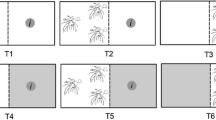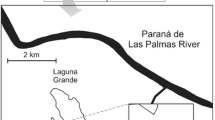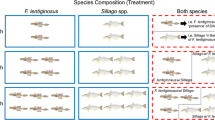Abstract
The structure of the habitat is usually crucial for growth and survival of young life stages. Presently, some nursery areas of fish larvae are changing due to eutrophication, e.g. due to enhanced growth of ephemeral filamentous algae at the expense of perennial species. We studied the influence of two habitats, one with filamentous algae (Cladophora glomerata) and the other with bladder wrack (Fucus vesiculosus), on habitat choice of pike larvae (Esox lucius) in the absence/presence of a predator or a competitor. We further tested whether the habitat choice is adaptive in increasing survival under predation threat. In contrast to expectations, pike larvae preferred the habitat with ephemeral filamentous algae to the bladder wrack, thriving in clean waters, independent of the presence/absence of both predator/competitor. In addition, the survival of the larvae was higher in the filamentous algae in the presence of predators, which suggested that the habitat preference of the larvae was adaptive. The structure of the bladderwrack habitat was probably too open for newly hatched larvae, which implies that F. vesiculosus and other large brown algae are not as important refuges for young larvae as previously thought.




Similar content being viewed by others
References
Amaral ACZ, Jablonski S (2005) Conservation of marine and coastal biodiversity in Brazil. Cons Biol 19:625–631
Aneer G (1987) High natural mortality of Baltic herring (Clupea harengus) eggs caused by algal exudates? Mar Biol 94:163–169. DOI 10.1007/BF00392928
Armbruster P, Lande R (1993) A population viability analysis for African elephant (Loxodonta africana)—how big should reserves be? Cons Biol 7:602–610
Borg Å, Pihl L, Wennhage H (1997) Habitat choice by juvenile cod (Gadus morhua L.) on sandy soft bottoms with different vegetation types. Helgoländer Meeresunters 51:197–212
Candolin U, Voigt H-R (1998) Predator-induced nest site preference: safe nests allow courtship in sticklebacks. Anim Behav 56:1205-1211. DOI 10.1006/anbe.1998.0892
Casselman JM (1996) Age, growth and environmental requirements of pike. In: Craig JF (ed) Pike—biology and exploitation. Chapman & Hall, London, pp 70–101
Casselman JM, Lewis CA (1996) Habitat requirements of northern pike (Esox lucius). Can J Fish Aquat Sci 53(Suppl 1):161–174
Connor EF, McCoy ED (1979) The statistics and biology of the species–area relationship. Am Nat 113:791–833
Craig JF (ed) (1996) Pike—biology and exploitation, 1st edn. Chapman & Hall, London
Craig JF, Babaluk JA (1989) Relationship of condition of walleye (Stizostedion vitreum) and northern pike (Esox lucius) to water clarity, with special reference to Dauphin Lake, Manitoba. Can J Fish Aquat Sci 46:1581–1586
Diehl S (1988) Foraging efficiency of three freshwater fishes: effects of structural complexity and light. Oikos 53:207–214
Downes BJ, Lake PS, Schreiber ESG, Glaister A (1998) Habitat structure and regulation of local species diversity in a stony, upland stream. Ecol Monogr 68:237–257
Eklöv P, Diehl S (1994) Piscivore efficiency and refuging prey: the importance of predator search mode. Oecologia 98:344–353. DOI 10.1007/BF00324223
Engström-Öst J, Isaksson I (2006) Effects of macroalgal exudates and oxygen deficiency on survival and behaviour of fish larvae. J Exp Mar Biol Ecol 335:227–234. DOI 10.1016/j.jembe.2006.03.007
Engström-Öst J, Lehtiniemi M (2004) Threat-sensitive predator avoidance by pike larvae. J Fish Biol 65:251–261. DOI 10.1111/j.0022-1112.2004.00448.x
Engström-Öst J, Lehtiniemi M, Jónasdóttir SH, Viitasalo M (2005) Growth of pike larvae (Esox lucius) under different conditions of food quality and salinity. Ecol Freshwat Fish 14:385–393. DOI 10.1111/j.1600-0633.2005.00113.x
Flynn AJ, Ritz DA (1999) Effect of habitat complexity and predator style on capture success of fish feeding on aggregated prey. J Mar Biol Ass UK 79:487–494
Isaksson I, Pihl L (1992) Structural changes in benthic macrovegetation and associated epibenthic faunal communities. Neth J Sea Res 30:131–140
Isaksson I, Pihl L, van Montfrans J (1994) Eutrophication-related changes in macrovegetation and foraging of young cod (Gadus morhua L.): a mesocosm experiment. J Exp Mar Biol Ecol 177:203–217. DOI 10.1016/0022-0981(94)90237-2
Johnson DA, Welsh BL (1985) Detrimental effects of Ulva lactuca (L.) exudates and low oxygen on estuarine crab larvae. J Exp Mar Biol Ecol 86:73–83. DOI 10.1016/0022-0981(85)90043-7
Kohn AJ, Leviten PJ (1976) Effect of habitat complexity on population density and species richness in tropical intertidal predatory gastropod assemblages. Oecologia 25:199–210. DOI 10.1007/BF00345098
Koivula K, Rönkä A (1998) Habitat deterioration and efficiency of antipredator strategy in a meadow-breeding wader, Temminck’s stint (Calidris temminckii). Oecologia 116:348–355. DOI 10.1007/s004420050597
Lappalainen A (2002) The effects of recent eutrophication on freshwater fish communities and fishery on the northern coast of the Gulf of Finland, Baltic Sea. PhD Thesis, University of Helsinki, 24 p
Leger DW, Didrichsons IA (1994) An assessment of data pooling and some alternatives. Anim Behav 48:823–832. DOI 10.1006/anbe.1994.1306
Lehtiniemi M (2005) Swim or hide—predator cues cause species specific reactions in young fish larvae. J Fish Biol 66:1285–1299. DOI 10.1111/j.0022-1112.2005.00681.x
Lehtonen H (1986) Fluctuations and long-term trends in the pike Esox lucius (L.) population in Nothamn, western Gulf of Finland. Aqua Fenn 16:3–9
Lemmetyinen R, Mankki J (1975) The three-spined stickleback (Gasterosteus aculeatus) in the food chain of the northern Baltic Sea. Merentutkimuslait Julk/Havsforskningsinst Skr 239:155–161
Lindén E, Lehtiniemi M, Viitasalo M (2003) Predator avoidance behaviour of Baltic littoral mysids Neomysis integer and Praunus flexuosus. Mar Biol 143:845–850. DOI 10.1007/s00227-003-1149-x
Milinski M (1986) Constraints placed by predators on feeding behaviour. In: Pitcher TJ (ed) The behaviour of teleost fishes. John Hopkins University Press, Baltimore, pp 236–252
Moksnes P-O, Pihl L, van Montfrans J (1998) Predation on postlarvae and juveniles of the shore crab Carcinus maenas: importance of shelter, size and cannibalism. Mar Ecol Prog Ser 166:211–225
Nilsson J, Andersson J, Karås P, Sandström O (2004) Recruitment failure and decreasing catches of perch (Perca fluviatilis L.) and pike (Esox lucius L.) in the coastal waters of southeast Sweden. Boreal Environ Res 9:295–306
Norkko J, Bonsdorff E, Norkko A (2000) Drifting algal mats as an alternative habitat for benthic invertebrates: Species-specific responses to a transient resource. J Exp Mar Biol Ecol 248:79–104. DOI 10.1016/S0022-0981(00)00155-6
Ojaveer E, Lindroth A, Bagge O, Lehtonen H, Toivonen J (1981) Fishes and fisheries. In: Voipio A (ed) The Baltic Sea. Elsevier, Amsterdam, pp 275–350
Ormerod SJ, Tyler SJ (1990) Assessments of body condition in dippers Cinclus cinclus: potential pitfalls in the derivation and use of condition indices based on body proportions. Ring Migr 11:31–41
Pedersen BH (1997) The cost of growth in young fish larvae, a review of new hypotheses. Aquaculture 155:259–269
Persson L, Crowder LB (1997) Fish-habitat interactions mediated via ontogenetic niche shifts. Ecol Stud Ser 131:3–23
Pöyry J, Lindgren S, Salminen J, Kuussaari M (2005) Responses of butterfly and moth species to restored cattle grazing in semi-natural grasslands. Biol Cons 122:465–478
Roast SD, Widdows J, Pope N, Jones MB (2004) Sediment-biota interactions: Mysid feeding activity enhances water turbidity and sediment erodability. Mar Ecol Prog Ser 281:145–154
Rudstam LG, Hansson S, Larsson U (1986) Abundance, species composition and production of mysid shrimps in a coastal area of the northern Baltic proper. Ophelia Suppl 4:225–238
Salovius-Laurén S (2004) Drifting and attached macroalgae: distribution, degradation and utility for macroinvertebrates. PhD Thesis, Åbo Akademi University, 36 p
Selén R (1999) Haukikannan muutokset läntisen Suomenlahden ulkosaaristossa 1939–1996 - Tutkimuskohteena Nothamnin saaristoalueen haukikanta (in Finnish). MSc Thesis, Univ Helsinki, 47 p
Sih A (1997) To hide or not to hide? Refuge use in a fluctuating environment. Trends Ecol Evol 12:375–376
Skov C, Berg S, Jacobsen L, Jepsen N (2002) Habitat use and foraging success of 0+ pike (Esox lucius L.) in experimental ponds related to prey fish, water transparency and light intensity. Ecol Freshwat Fish 11:65–73. DOI 10.1034/j.1600-0633.2002.00008.x
Skov C, Jacobsen L, Berg S (2003) Post-stocking survival of 0+ pike in ponds as a function of water transparency, habitat complexity, prey availability and size heterogeneity. J Fish Biol 62:311–322. DOI 10.1046/j.1095-8649.2003.00023.x
Sokal RR, Rohlf FJ (1995) Biometry. W.H. Freeman and Company, New York
Vøllestad LA, Skurdal J, Qvenild T (1986) Habitat use, growth, and feeding of pike (Esox lucius L.) in four Norwegian lakes. Arch Hydrobiol 108:107–117
Wallentinus I (1984) Comparisons of nutrient uptake rates for Baltic macro-algae with different thallus morphologies. Mar Biol 80:215–225. DOI 10.1007/BF02180189
Wennhage H, Pihl L (1994) Substratum selection by juvenile plaice (Pleuronectes platessa L.): impact of benthic microalgae and filamentous macroalgae. Neth J Sea Res 32:343–351
Werner EE, Gilliam JF, Hall DJ, Mittelbach GG (1983) An experimental test of the effects of predation risk on habitat use in fish. Ecology 64:1540–1548
Werner RG (2002) Habitat requirements. In: Fuiman LA, Werner RG (eds) Fishery science—the unique contributions of early life stages. Blackwell, Oxford, pp 161–182
Wootton RJ (1984) A functional biology of sticklebacks. Croom Helm, London & Sidney
Acknowledgments
We wish to thank two reviewers for valuable comments on the manuscript. H. Strandberg gave us the pike larvae. M. Lehtiniemi taught us stomach analysis. M. Viitasalo purchased the fish tanks. A.-M. Åström weighed the algae. M. Öst showed us how to use the condition index and helped with statistical issues. J. Lindeberg was responsible for animal care. Tvärminne Zoological Station provided working facilities and accommodation. We greatly acknowledge funding from the Academy of Finland (to J.E.-Ö.) (project no. 202382), and Walter and Andrée de Nottbeck Foundation (to E.I.). The experiments comply with current laws of Finland. Animal welfare was respected during all stages of the study. Permission (no. 69–04) was granted by the Animal Care Committee at the University of Helsinki, Finland.
Author information
Authors and Affiliations
Corresponding author
Additional information
Communicated by M. Kühl, Helsingør.
Rights and permissions
About this article
Cite this article
Engström-Öst, J., Immonen, E., Candolin, U. et al. The indirect effects of eutrophication on habitat choice and survival of fish larvae in the Baltic Sea. Mar Biol 151, 393–400 (2007). https://doi.org/10.1007/s00227-006-0498-7
Received:
Accepted:
Published:
Issue Date:
DOI: https://doi.org/10.1007/s00227-006-0498-7




